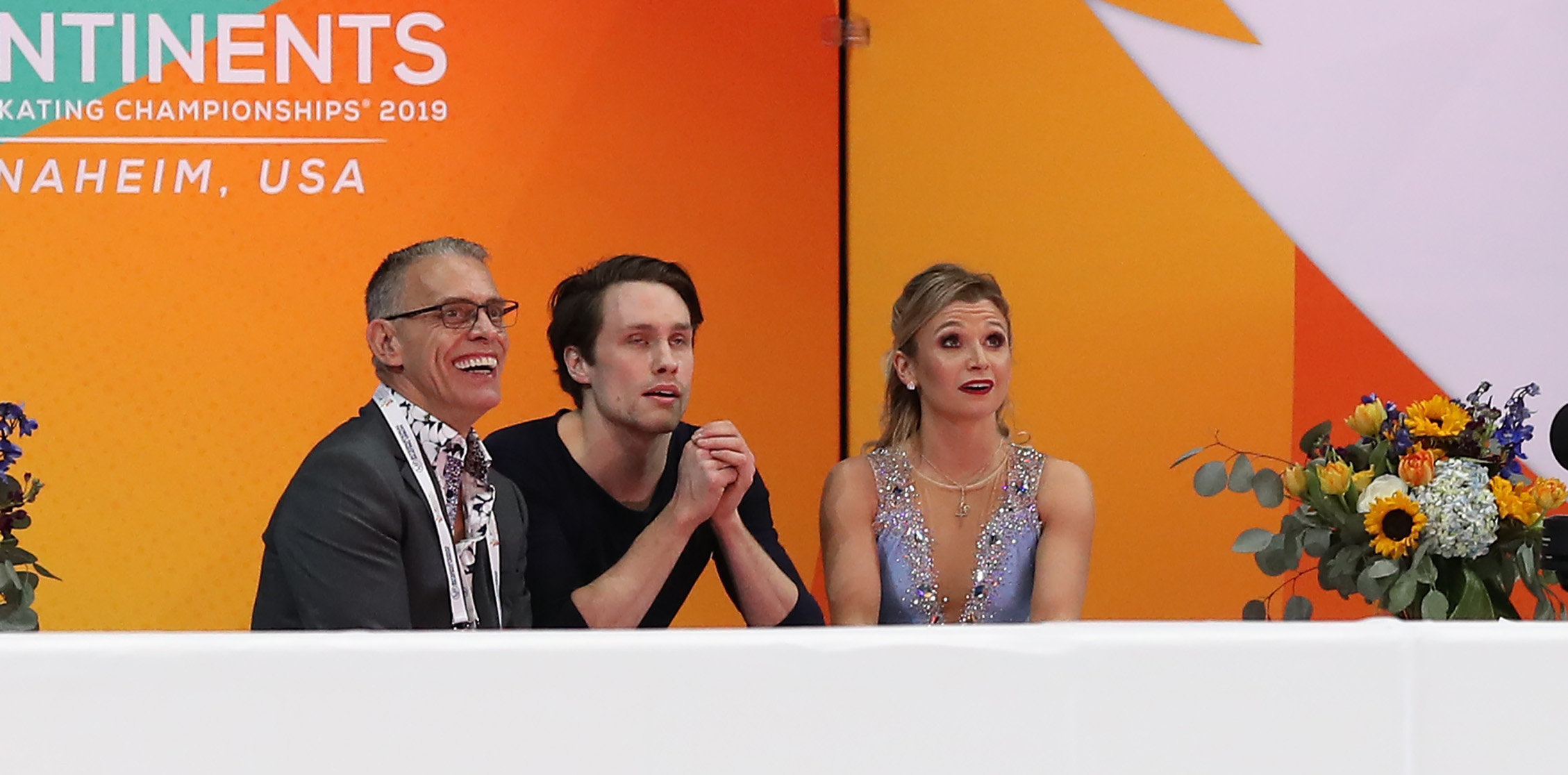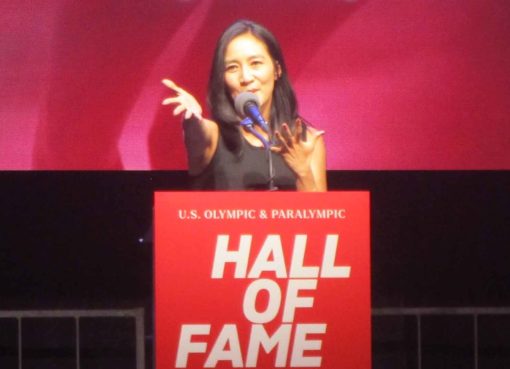By Claire Cloutier, Team FSO contributing writer
Photos by Robin Ritoss and Claire Cloutier
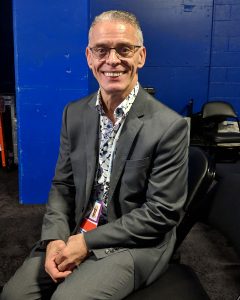 ANAHEIM, CALIF. — Richard Gauthier of Canada has been a renowned coach in the pairs skating world for many years now. Based in Montreal, where he currently coaches with Bruno Marcotte, Gauthier has led many pairs to international success over the past 20 years, most notably two-time World champions and Olympic medalists Meagan Duhamel and Eric Radford (who he coached up until 2017-18 season); and 2002 Olympic Champions Jamie Sale and David Pelletier. At the Four Continents Championships, Gauthier’s current team, Kirsten Moore-Towers and Michael Marinaro, won the silver medal. After the pairs short program in Anaheim, Gauthier kindly took a few minutes to share his thoughts with Figure Skaters Online‘s Claire Cloutier on some of his current teams, the top contenders in pairs going into Worlds, and the impact of recent rules changes on the discipline of pairs skating.
ANAHEIM, CALIF. — Richard Gauthier of Canada has been a renowned coach in the pairs skating world for many years now. Based in Montreal, where he currently coaches with Bruno Marcotte, Gauthier has led many pairs to international success over the past 20 years, most notably two-time World champions and Olympic medalists Meagan Duhamel and Eric Radford (who he coached up until 2017-18 season); and 2002 Olympic Champions Jamie Sale and David Pelletier. At the Four Continents Championships, Gauthier’s current team, Kirsten Moore-Towers and Michael Marinaro, won the silver medal. After the pairs short program in Anaheim, Gauthier kindly took a few minutes to share his thoughts with Figure Skaters Online‘s Claire Cloutier on some of his current teams, the top contenders in pairs going into Worlds, and the impact of recent rules changes on the discipline of pairs skating.
Figure Skaters Online(FSO): You and Bruno Marcotte have a pretty big pairs school right now. You had two pairs competing at Four Continents, right?
Richard Gauthier (RG): Actually, we had three. But the Australian team [Ekaterina Alexandrovskaya and Harley Windsor] had to withdraw due to injury.
FSO: Yes. What is Alexandroskava and Windsor’s situation right now?
RG: We actually don’t really know. We’re still waiting to get results. His foot started to swell. I think the cause might be his skate. They did some blood tests and an MRI, and we’re waiting for the result. The swelling’s gone down, but as soon as he put his skates [on], it seems to get back. So I would think it might be his skate. I hope it is because we still have the World Championships coming. And after their [Australian] Nationals…I was questioning the long program all season. And at Nationals, we decided, let’s make a whole new long [program]. We were hoping to do it here [at Four Continents], to get some practice. But I guess it’s going to have to be at Worlds.
FSO: That’s a big change. What are they switching to?
RG: It’s more classical. They had this tango, and the music was kind of repetitious– Scent of a Woman. It just didn’t fit them. As juniors, you do elements, and the music…. You try to put the music, but the most important thing is to get the elements. Now they’re at a level where they need to really emote. The choreographer that they had planned, it was before they came with me. And [he] picked the music, but never worked with them [before]. You need to know the skaters, their personalities, before you pick the music and put the program together. So in the meantime, the short program was done with Julie Marcotte, who does most of my programs. And she’s really good at finding styles that fit the skaters. So after we came back from Nationals, I said, ‘I have a really big favor to ask. Can you make a long program really fast?’ She did a really good job. The music builds up, it’s more their style of music. And they picked the music together, rather than having the choreographer come in with, ‘This is what you’re going to skate to.’ It was a combination of all of us together. Hopefully, they’ll be able to skate that [at Worlds]. But it’s probably a long [program] that we’ll keep for the next season, because they will probably have done only one competition with it. Sometimes, the skaters start playing the music and they skate to it, and it seems like a twenty-minute program. And then you know something’s wrong. And there’s other ones that you’re like, ‘Oh, it’s finished already?’ But I think now their long has this [quality]. We’ll have to wait and see.
FSO: Your top team here at Four Continents, Kirsten Moore-Towers and Michael Marinaro, obviously did really well in the short program.
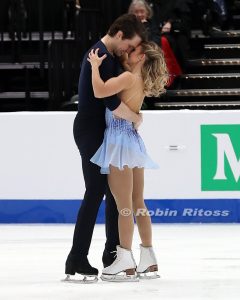 RG: Yes, I’m very happy for them. They’ve been doing better and better. They’ve improved a lot. The problem is when we got to competition, they always seemed to be trying a bit too hard. Like if you go and watch them on practice, Kirsten hardly misses anything and everything seems to be easy. And every time we went to competition, she would land them [jumps], but something would be [off]. So the approach we took yesterday after practice…. I said, ‘Listen, you guys had a great practice. We need to be able to repeat this.’ What happened in every competition with Mike– Last year, he would get on the ice for warm-up and he would speed up, trying to get his heartbeat going. But by doing this, everything was going too fast. So when he went into his jump, he would force his jump, trying to jump with his upper body instead of using his legs. And it would speed her [Kirsten] up. They would both speed each other up, in a way that was not what they do every day. So I said, ‘Instead of trying too hard, just pretend [it’s how] we do it every day. And when you get on the ice, Mike …’ I asked him to slow down his warm-up. Just doing some long strokes, instead of going fast, fast, fast. And I said: ‘Because if you speed up, she’s going to speed up. And then by the end of the program, everything is out of control.’ Today, they tried it, and look at [the results]. With skaters, it varies. Some of them, they need stroking, [or] they sometimes need to speed up. He knows now that he has to take his time. So I think today’s going to help them in the future. It takes three years to really know what works for the team. And this is now the time for them to put out what they do in practice every day.
RG: Yes, I’m very happy for them. They’ve been doing better and better. They’ve improved a lot. The problem is when we got to competition, they always seemed to be trying a bit too hard. Like if you go and watch them on practice, Kirsten hardly misses anything and everything seems to be easy. And every time we went to competition, she would land them [jumps], but something would be [off]. So the approach we took yesterday after practice…. I said, ‘Listen, you guys had a great practice. We need to be able to repeat this.’ What happened in every competition with Mike– Last year, he would get on the ice for warm-up and he would speed up, trying to get his heartbeat going. But by doing this, everything was going too fast. So when he went into his jump, he would force his jump, trying to jump with his upper body instead of using his legs. And it would speed her [Kirsten] up. They would both speed each other up, in a way that was not what they do every day. So I said, ‘Instead of trying too hard, just pretend [it’s how] we do it every day. And when you get on the ice, Mike …’ I asked him to slow down his warm-up. Just doing some long strokes, instead of going fast, fast, fast. And I said: ‘Because if you speed up, she’s going to speed up. And then by the end of the program, everything is out of control.’ Today, they tried it, and look at [the results]. With skaters, it varies. Some of them, they need stroking, [or] they sometimes need to speed up. He knows now that he has to take his time. So I think today’s going to help them in the future. It takes three years to really know what works for the team. And this is now the time for them to put out what they do in practice every day.
FSO: Do you feel like Kirsten and Mike are getting to the point where they can compete with the top pairs in the world? They beat Wenjing Sui and Cong Han here in the short program.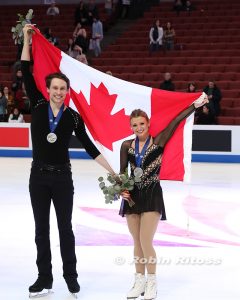
RG: Yes, yes. I think Kirsten had this when Mike came with her. Up until last year, I always felt like Mike had to catch up to Kirsten. Now I think they’re able to compete together, and you’re not watching him more than her, or you’re not thinking about if he can have a bit more flow. Up until last year, often in competition, Mike would land [jumps] on two feet. Now, rarely will he do it, day to day. We had a new singles coach join our school–actually, two of them–and they’re probably two of the best coaches we have in Canada in singles. They helped take the technique apart of the jump for Mike. Now things just seem to be heading into place. And technically, I think they have elements that are strong. The good thing this year is after the Olympics, a lot of the old pairs teams retired, so it opens up. Other than the Chinese [Sui and Han], everyone else is part of the new generation. This next Olympics, there will be a bunch of the new generation. So it opens up for all of them, and gives them a chance to get to the podium before it’s too late.
FSO: Vanessa James and Morgan Cipres and Evgenia Tarasova and Vladimir Morozov recently competed at Europeans, and Sui and Han are competing here at Four Continents. What are your thoughts on the condition of the top teams this season?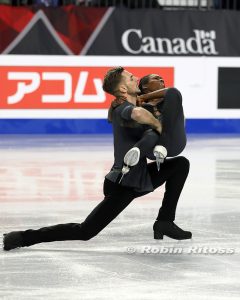
RG: James and Cipres…. Their short program, to me, it’s like almost everybody else. But their long program is something special and they’ve been performing it really well. I hope for them, they do good, because I think Vanessa’s been there a long time. She represented so many countries, had different partners and I think it’s her time. She deserves it. I hope so, for them. 
Tarasova and Morozov…. Their [long] program, this year, is better than last year. I think it fits them better. They’ve tried some new stuff, which was not really the style I think they should have gone for. And I think they realize that their marks, the components, were not as high as they could [be]. It’s a team that has a lot of potential. They need to get out there and nail this stuff, though. I think they have a better vehicle this year.
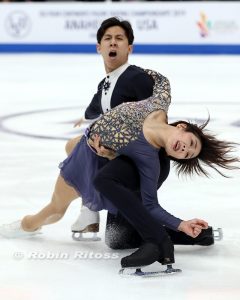 The Chinese [Sui and Han], you can’t take away from what they have. It’s something that’s special. Even if they’re not really tall, they have professional quality. And actually, when you watch her skate, she’s very mature on the ice. They look like kids when you see them first get on the ice. But as soon as they start skating, you don’t notice that they’re short compared to the other teams. And it’s the quality, and the way they feel the music, that I think draws you to watch them when they skate.
The Chinese [Sui and Han], you can’t take away from what they have. It’s something that’s special. Even if they’re not really tall, they have professional quality. And actually, when you watch her skate, she’s very mature on the ice. They look like kids when you see them first get on the ice. But as soon as they start skating, you don’t notice that they’re short compared to the other teams. And it’s the quality, and the way they feel the music, that I think draws you to watch them when they skate.
It’ll be between these three teams, really, for the [World] title. Unless somebody ran up too high after the short [program] and can’t handle the pressure of thinking they can win this. In the past, the French team, they’re good when they don’t do a good short. And then they have to climb up in the long. If they did a good short, it might be hard for them to propel this for the long program.
The Russians…. Sometimes I wonder if they realize where they’re at and all the potential they have because it always seems to be the same. They don’t look more stressed or more relaxed, they might [skate well] or miss something, but I don’t see much of a difference in them. The quality of their elements on the ice … they have great elements. I’d like, maybe, to see something different from them when they come out. I know they tried last year, with changing the style of their program. I don’t think the style was right. But I kind of see the same team over the year, I don’t see really that much of a difference.
Compared to Vanessa and Morgan this year.. they really went out for the long program to find a piece [of music] that fits them. It’s one of those programs that they get to the end and you go, “Oh, it’s finished already? Can we have an encore, because it goes like this?” [Snaps fingers.]
With Tarasova and Morozov, I mean definitely the program is better, but we never know if the elements are going to be there. I had forgot about the Chinese because I hadn’t seen them on the circuit this fall. But when you have all three of them on the ice, then it’s easier to compare. It’s easier to compare the quality.
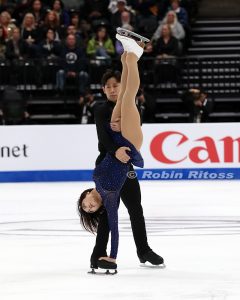 FSO: I feel that Sui/Han look good right now, but perhaps not in their peak condition.
FSO: I feel that Sui/Han look good right now, but perhaps not in their peak condition.
RG: Yes. Because the thing is, they haven’t competed this year so this is the first time they go out. I mean, when you’re first on the Grand Prix, you do a few mistakes, you polish your program, you adjust things as the season goes along. By this time now, you’ve done all the changes that you need to do. They’re maybe a bit behind. But it’s still five weeks before Worlds and I think they’ll go back home and make sure they get the work done and try to polish as much as they can. It’s an old team [i.e., experienced]. It’s probably the oldest team that we have right now in the world. They’ve been more than 10 years together. So there’s some things that become almost like walking. They don’t even have to think about it. The elements will be there. They have to focus more on the performance. And maybe, just get the cardio going, so they can keep the speed. I found today, his lift was a bit slow and didn’t cover much ice. But on practice, I saw this lift with the quality. I think they just need a bit of mileage. The mistake she made today, on the [side-by-side] jump, is not something that will happen too many times. The other ones, though. The Russians, there’s always a little something that happens that just gives it away. And the French are really good at winning the race from behind.
Then, if something happened, Mike and Kirsten could squeeze in. Like today, for example, on that [short program] warm-up, it was a big crowd for the Chinese and outstanding for the Americans, and not so much for them. I said: ‘This is good because the focus is not on you guys, and it’s always easier to come when you’re behind, when no one’s expecting it.’ And you don’t expect so much from yourself.
I’m sure the French know they could win this [Worlds], because of the results they’ve had all season. The Russians also. They forgot that these guys [Sui and Han] are coming. They saw them probably today–they’ll watch it. No one knew what to expect, because they’ve been out for a while, so we didn’t know what the program looked like. But I think they’ve got some good material. It’ll be one of those three [at Worlds].
FSO: There have been a number of rules changes this year. What are your thoughts about the rules changes to lifts? They’ve made it a little more difficult to get level 4 lifts.
RG: I don’t see that much difference in the lifts. I find the kids seem to forget to keep the focus on [during competition]. If you watch them on practice, there’s not that many lifts that are being missed. The ones who are missing sometimes, some are too close in height, so that would make the difference. But if the girl is fairly small, it’s just a lack of focus on the lift. The [main] difference this year is you can’t repeat some of these positions. Like if you use an exit, you can’t use it again for another lift. So this is where some of them had to be more creative.
But the lifts that you see now, I think they will keep these lifts for the next few years. You change the music, but if you get a level 4 lift and you get a good GOE on it, you don’t really want to change this. Because there’s other elements–the jumps and the throws–that people would miss. So they’ll focus more on this. Any team that’s skated together for two years, they’ve gone through all three death spirals. [A different death spiral is required in the short program each year.] So most of these teams, they’ve mastered the death spiral, [and] the spin won’t really change from one year to another. Unless they do everything perfect, and they think, We need a little challenge on one element. But most of the time, they will keep the same elements for a long time.
FSO: What do you think about the pairs long programs changing from 4:30 down to 4:00 in length?
RG: Actually, I find it’s harder for the skaters. Because yes, they did take one element out [side-by-side spin], but the time that it takes to do a side-by-side spin or a pairs spin, it’s less than 30 seconds. So all you end up doing is you have to combine your elements really close together. Let’s say you come out of the throw, and you go right into the jump. To be able to have some time to do choreography …. I remember when the long program was 5:00. It was the same amount of elements, but it was easier because you had time to stop and work on the choreography and create more on the ice. Now, you have to get all the elements in … it’s not much time. If you miss one element, you get late for the other elements.
I think for the choreographer, it’s a lot harder for them. If the skaters are acting something, you have to believe it. Choreography-wise, that 30 seconds was just giving them some place in the program where they could stop and pose and regroup and then catch their breath and go back again. Now, if they have a program that goes too fast from the beginning to the end, it’s sprint–go–sprint–go–sprint–go. It’s a lot harder on their neck and the cardio.
And the lifts …. These lifts are taking longer than before, if you want to get a level 4. Something’s going to be squeezed. Because if you want to get all three lifts level 4 and if you want to cover ice–a nice lift covers a lot of ice–and they should have the same speed at the end. So if you’re going to cover from one end to the other, that’s about 20 seconds. If you have these three lifts, there’s not much time for the rest of the elements.
I understand that, for television, they needed things to be a bit less long. But I would have maybe taken the choreographic section [sequence] out. This part, I find, takes a long time, like the step sequence in the short program. In pairs, the footwork looks pretty much all the same. It’s not like in dance, where they have all these intricate-type [steps]. By the time you get your turns, your crossing, and everything that is required to get a level 4 footwork, everybody’s looking the same. And it’s not an exciting element to watch. I think they’d be better off to leave it to interpretation of the music instead of having those elements.
I would maybe take one other element out. If they need less time in the pairs [long program], they could have two lifts instead of three. Then it’d be less dangerous. And they would not be as tired at the end. And they could better perform the program.
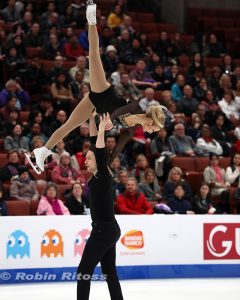 FSO: If they changed the requirement from three lifts to two lifts, though, wouldn’t that give too much of an advantage to the pairs who are stronger in jumping, as opposed to stronger in pairs elements?
FSO: If they changed the requirement from three lifts to two lifts, though, wouldn’t that give too much of an advantage to the pairs who are stronger in jumping, as opposed to stronger in pairs elements?
Gauthier: I don’t think so, because if everybody has two lifts–like they do in juniors–it just gives them more time to actually interpret the music. The two lifts would probably be better-quality and they would probably work on getting these lifts to cover ice more. Instead, it would give more credit to the best-quality lifts, instead of having these three lifts with all these changes of position and grabbing. I think it would be safer for the skaters and they would have more time to perform to the music.
In pairs, you’ve got to be strong in jumps and throws and lifts, but then you also have this other part, the components score, where you have to perform to the music. And by the time you’ve done all these elements, there’s not much time in between to do this. Some people are natural [at this]. The ones who are not natural, it doesn’t give them much time to really work on this. I think it would just give better quality. Even the stroking, the in-between transitions, they could have harder transitions. Right now, some of them, it’s just go up and lift, and then throw. It’s like they’re running after the time.
FSO: That’s my feeling, too. I just think with the reduction in the time of the long programs, it’s becoming very difficult.
RG: It’s like a long short program.
FSO: It’s becoming harder for the skaters to set a mood.
RG: I totally agree. And other than the people who have been together, like the Chinese [Sui/Hong], for a long time…. When they do these elements, she’s able to sell it in a way that you don’t even see this as an element. It’s part of their whole package, their whole story. The story from the beginning to the end. Whereas some of the skaters, they try to tell you a story, but then they go back to being athletes.
And that’s what our sport is all about. Our sport is one of the hardest ones [because] we’re asking these athletes to perform difficult elements, and then be an actor at the same time. And do this with a smile, like everything is easy. But it’s not that easy. [Laughs]
So let’s make the sport [that way]. That’s why people enjoy watching figure skating. Even if they don’t understand the sport, it’s just pleasant to watch.


